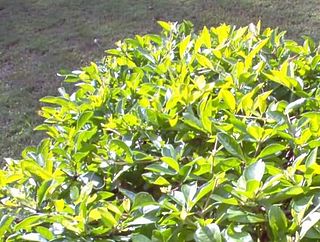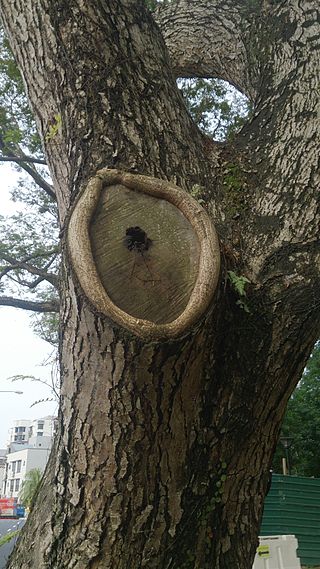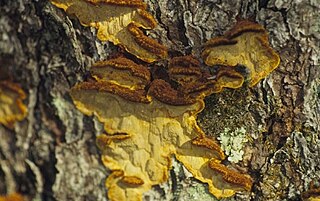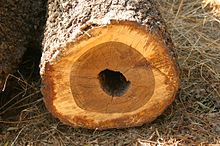
Bark is the outermost layers of stems and roots of woody plants. Plants with bark include trees, woody vines, and shrubs. Bark refers to all the tissues outside the vascular cambium and is a nontechnical term. It overlays the wood and consists of the inner bark and the outer bark. The inner bark, which in older stems is living tissue, includes the innermost layer of the periderm. The outer bark on older stems includes the dead tissue on the surface of the stems, along with parts of the outermost periderm and all the tissues on the outer side of the periderm. The outer bark on trees which lies external to the living periderm is also called the rhytidome.

Pruning is a horticultural, arboricultural, and silvicultural practice involving the selective removal of certain parts of a plant, such as branches, buds, or roots.

Armillaria mellea, commonly known as honey fungus, is a edible basidiomycete fungus in the genus Armillaria. It is a plant pathogen and part of a cryptic species complex of closely related and morphologically similar species. It causes Armillaria root rot in many plant species and produces mushrooms around the base of trees it has infected. The symptoms of infection appear in the crowns of infected trees as discoloured foliage, reduced growth, dieback of the branches and death. The mushrooms are edible but some people may be intolerant to them. This species is capable of producing light via bioluminescence in its mycelium.

Fomitopsis pinicola, is a stem decay fungus common on softwood and hardwood trees. Its conk is known as the red-belted conk. The species is common throughout temperate Europe and Asia. It is a decay fungus that serves as a small-scale disturbance agent in coastal rainforest ecosystems. It influences stand structure and succession in temperate rainforests. It performs essential nutrient cycling functions in forests. As well as a key producer of brown rot residues that are stable soil components in coniferous forest ecosystems. It has been reported that mushrooms have significant antioxidant activity.
Tree topping is the practice of removing whole tops of trees or large branches and/or trunks from the tops of trees, leaving stubs or lateral branches that are too small to assume the role of a terminal leader. Other common names for the practice include hat-racking, heading, rounding over, and tipping. Some species of trees are more likely to recover from topping than others. There are alternatives to topping that can help to achieve the same goals without damaging trees.

Slime flux, also known as bacterial slime or bacterial wetwood, is a bacterial disease of certain trees, primarily elm, cottonwood, poplar, boxelder, ash, aspen, fruitless mulberry and oak. A wound to the bark, caused by pruning, insects, poor branch angles or natural cracks and splits, causes sap to ooze from the wound. Bacteria may infect this sap causing it to darken and stain the bark, eventually taking on a foamy appearance and unpleasant odor. This slimy ooze becomes toxic to the bark and eats into the tree. Additionally, the fermented sap attracts insects like flies, ants, and maggots.

A wood-decay or xylophagous fungus is any species of fungus that digests moist wood, causing it to rot. Some species of wood-decay fungi attack dead wood, such as brown rot, and some, such as Armillaria, are parasitic and colonize living trees. Excessive moisture above the fibre saturation point in wood is required for fungal colonization and proliferation. In nature, this process causes the breakdown of complex molecules and leads to the return of nutrients to the soil. Wood-decay fungi consume wood in various ways; for example, some attack the carbohydrates in wood, and some others decay lignin. The rate of decay of wooden materials in various climates can be estimated by empirical models.

A branch collar is the "shoulder" between the branch and trunk of woody plants; the inflammation formed at the base of the branch is caused by annually overlapping trunk tissue. The shape of the branch collar is due to two separate growth patterns, initially the branch grows basipetally, followed by seasonal trunk growth which envelops the branch.

Nectria cinnabarina, also known as coral spot, is a plant pathogen that causes cankers on broadleaf trees. This disease is polycyclic and infects trees in the cool temperate regions of the Northern Hemisphere. N. cinnabarina is typically saprophytic, but will act as a weak parasite if presented with an opportunity via wounds in the tree or other stressors that weaken the tree's defense to the disease. A study published in 2011 showed that this complex consists of at least 4 distinct species. There are only a few ways to manage this disease with techniques such as sanitation and pruning away branches that have the cankers. N. cinnabarina is not as significant a problem as other Nectria spp., some of which are the most important pathogens to infect hardwood trees.
The plant pathogenic fungus Leucostoma kunzei is the causal agent of Leucostoma canker, a disease of spruce trees found in the Northern Hemisphere, predominantly on Norway spruce and Colorado blue spruce. This disease is one of the most common and detrimental stem diseases of Picea species in the northeastern United States, yet it also affects other coniferous species. Rarely does it kill its host tree; however, the disease does disfigure by killing host branches and causing resin exudation from perennial lesions on branches or trunks.

Stereum sanguinolentum is a species of fungus in the Stereaceae family. A plant pathogen, it causes red heart rot, a red discoloration on conifers, particularly spruces or Douglas-firs. Fruit bodies are produced on dead wood, or sometimes on dead branches of living trees. They are a thin leathery crust of the wood surface. Fresh fruit bodies will bleed a red-colored juice if injured, reflected in the common names bleeding Stereum or the bleeding conifer parchment. It can be the host of the parasitic jelly fungus Tremella encephala.

Phellinus pini is a fungal plant pathogen that causes tree disease commonly known as "red ring rot" or "white speck". This disease, extremely common in the conifers of North America, decays tree trunks, rendering them useless for lumber. It is a rot of the heartwood. Signs of the fungus include shelf-shaped conks protruding from the trunks of trees. Spores produced on these conks are blown by the wind and go on to infect other trees. Formal management of this disease is limited, and the disease is controlled primarily by cultural practices. Red ring rot is an important forest disturbance agent and plays a key role in habitat formation for several forest animals.

Laminated root rot also known as yellow ring rot is caused by the fungal pathogen Phellinus weirii. Laminated root rot is one of the most damaging root disease amongst conifers in northwestern America and true firs, Douglas fir, Mountain hemlock, and Western hemlock are highly susceptible to infection with P. weirii. A few species of plants such as Western white pine and Lodgepole pine are tolerant to the pathogen while Ponderosa pine is resistant to it. Only hardwoods are known to be immune to the pathogen.

Ascocoryne sarcoides is a species of fungus in the family Helotiaceae. The species name is derived from the Greek sarkodes (fleshy). Formerly known as Coryne sarcoides, its taxonomical history has been complicated by the fact that it may adopt both sexual and asexual forms. Colloquially known as jelly drops or the purple jellydisc, this common fungus appears as a gelatinous mass of pinkish or purple-colored discs. Distributed widely in North America, Europe and Asia, A. sarcoides is a saprobic fungus and grows in clusters on the trunks and branches of a variety of dead woods. Field studies suggest that colonization by A. sarcoides of the heartwood of black spruce confers some resistance to further infection by rot-causing fungi. A. sarcoides contains the antibiotic compound ascocorynin, shown in the laboratory to inhibit the growth of several Gram-positive bacteria.
Forest pathology is the research of both biotic and abiotic maladies affecting the health of a forest ecosystem, primarily fungal pathogens and their insect vectors. It is a subfield of forestry and plant pathology.

Armillaria root rot is a fungal root rot caused by several different members of the genus Armillaria. The symptoms are variable depending on the host infected, ranging from stunted leaves to chlorotic needles and dieback of twigs and branches. However, all infected hosts display symptoms characteristic of being infected by a white rotting fungus. The most effective ways of management focus on limiting the spread of the fungus, planting resistant species, and removing infected material. This disease poses a threat to the lumber industry as well as affecting recreational areas.

Heterobasidion irregulare is a tree root rotting pathogenic fungus that belongs to the genus Heterobasidion, which includes important pathogens of conifers and other woody plants. It has a wide host and geographic range throughout North America and causes considerable economic damage in pine plantations in the United States. This fungus is also a serious worry in eastern Canada. Heterobasidion irregulare has been introduced to Italy (Lazio)(modifica) where it has been responsible for extensive tree mortality of stone pine. Due to the ecology, disease type, host range/preference, interfertility group, and genetic information, H. irregulare was designated a new species and distinguished from Heterobasidion occidentale.

Hypoxylon canker of shade trees is a weak ascomycete fungus that negatively affects growth and can eventually lead to the death of already dying or diseased host trees. There are many different species that affect different trees. For example, Hypoxylon atropunctatum, a common species, is found on oak trees, Hypoxylon tinctor affects sycamore trees, and Hypoxylon mammatum infests aspen trees.
Spruce broom rust or yellow witches' broom rust is a fungal plant disease caused by the basidiomycete fungus known as Chrysomyxa arctostaphyli. It occurs exclusively in North America, with the most concentrated outbreaks occurring in northern Arizona and southern Colorado on blue and Engelmann spruce, as well as in Alaska on black and white spruce. This disease alternates its life cycle between two hosts, with the spruce serving as the primary host and bearberry serving as the secondary or alternate host. The name for the disease comes from the distinctive “witches broom”, commonly yellow in color, which forms on the spruce after young needles have been infected. Management must be carried out through physical or mechanical methods, such as the pruning of brooms or the removal of the secondary host from the area, because no chemical control measures have yet been determined to be economically effective. Generally, spruce broom rust is seen as a mostly cosmetic issue, and it is very rarely the direct cause of tree death; however, research has shown a reduction in overall productivity and health of infected trees, making it an important issue for logging and timber companies.
Aspen trunk rot is a fungal disease that causes stem decay heart rot of living aspen trees. The pathogen that causes this disease is the fungus Phellinus tremulae. Most of the symptoms of this disease are internal, with the only external signs of a diseased aspen being fruiting bodies called conks. A single conk found on an aspen can indicate advanced decay of up 82% of the tree volume. Internal decayed wood of freshly cut aspens is spongy, yellow/white colored, surrounded by black zones of discoloration, and contains a distinct wintergreen smell. The fungus is spread via airborne spores released from the fruiting body which can infect through dead branches, branch stubs, or wounds in the tree. Although no direct management control is known, harvesting aspen stands that have been damaged or harvesting stands before decay becomes advanced minimizes tree loss. Aspen wood is white, malleable but strong, and heat-tolerant and therefore has many commercial uses including matches, packing paper, lumber, plywood, pulp, and animal beds. Aspen trees diseased with aspen trunk rot decrease the economic value of the lumber.
















